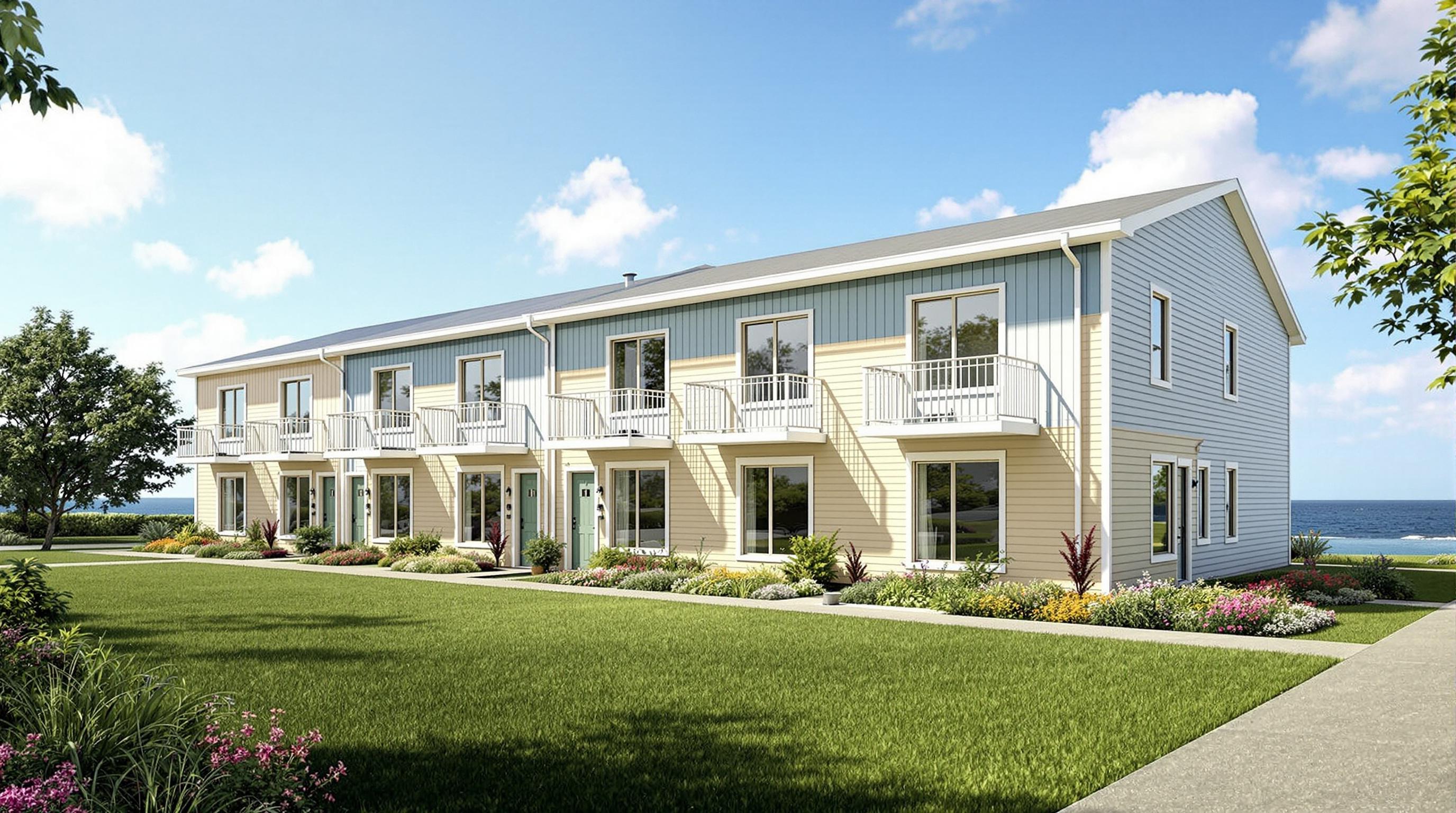Want to keep your construction budget under control? Fixed-price contracts in Nova Scotia lock in costs upfront, unlike cost-plus contracts, where expenses can spiral as materials and labour fluctuate.
Key Takeaways:
- Fixed-Price Contracts: Builders commit to a set price (e.g., $168/sq.ft), absorbing any extra costs. Predictable budgets, faster timelines, and reduced financial risks make it ideal for straightforward projects.
- Cost-Plus Contracts: Costs are variable, adding actual expenses plus a markup. This flexibility suits custom builds but often leads to budget overruns and delays.
Quick Comparison:
| Factor | Fixed-Price Contract | Cost-Plus Contract |
|---|---|---|
| Budget Certainty | Costs locked in | Costs vary |
| Risk Bearer | Builder | Client |
| Timeline | Shorter | Often longer |
| Final Cost Example | $595,000 (stable) | $875,600 (variable) |
Choose fixed-price for financial stability or cost-plus for flexibility. Your decision depends on project complexity and your risk tolerance.
Fixed-Price Contract Basics
Set Price Structure
A fixed-price contract locks in the total cost of your project. For example, at $168/sq.ft, building a 1,000-sq.ft property would cost $168,000. This price includes materials, labour, permits, and finishes, ensuring your budget remains steady even if market prices fluctuate. These clear cost guidelines help builders handle potential risks better.
Builder Risk Management
Builders use specific strategies to handle risks under fixed-price contracts:
| Strategy | How It Works | Advantage |
|---|---|---|
| Cost Tracking | Monitoring expenses daily | Keeps the project within budget |
| Optimized Scheduling | Smart task organization | Cuts down on delays |
| Integrated Team | In-house experts and trades | Improves coordination |
These strategies are key to ensuring the success of fixed-price contracts.
Fixed-Price Benefits
In Nova Scotia, where material costs and labour availability can vary, fixed-price contracts provide strong budget stability:
- Financial Predictability: A set price simplifies financial planning and can make getting loans easier. For example, Michael, a first-time developer, used a fixed-price contract at $173/sq.ft for his fourplex. The project stayed on track, finishing in nine months and generating $9,600 monthly in rental income [1].
- Risk Transfer: If unexpected costs arise, the builder absorbs them, protecting your investment [1].
- Faster Completion: AI-driven scheduling can shave weeks off construction time, allowing you to start earning rental income sooner [1].
Cost-Plus Contract Basics
Variable Cost Structure
With cost-plus contracts, the total cost includes actual project expenses plus a builder's markup. Any increases in costs are passed directly to the client. Here's how the structure typically breaks down:
| Component | Description | Impact on Final Cost |
|---|---|---|
| Base Materials | Cost of building materials | Directly added to the total |
| Labour Hours | Time spent by trades and workers | Charged at market rates |
| Builder's Markup | Percentage added to total expenses | Increases as costs rise |
| Overhead Fees | Administrative and management costs | Added to the final amount |
Cost-Plus Risk Factors
In Nova Scotia, cost-plus contracts often lead to budget overruns and delays. Take property investor Sarah K.'s experience as an example:
"What was supposed to be a 6-month project is now in month 14. Each delay drained my confidence and potential rent. My carrying costs have doubled." [1]
Budget overruns are another common issue. First-time developer John D. shared his struggles:
"I thought I'd accounted for everything... then one 'surprise' cost after another. Now I'm $78,000 beyond my plan with no end in sight." [1]
Delays can also stem from miscommunication among project teams. Real estate investor Michael T. described his frustration:
"Engineer blamed the contractor, who blamed the architect... I was trapped in the middle losing $3,200 every week of delays while they argued." [1]
These examples highlight the risks involved and emphasize the importance of understanding when a cost-plus approach might be suitable.
Cost-Plus Applications
While cost-plus contracts come with higher financial risks, they can work well for projects requiring flexibility in scope. However, a key issue remains: as costs increase, so does the builder's profit margin [1]. This can create a conflict of interest between the builder and client, especially in regions like Nova Scotia where material costs can fluctuate significantly. Builders under cost-plus agreements have little incentive to keep expenses in check, unlike fixed-price contracts where they bear the burden of cost increases [1].
Cost Plus vs Fixed Price (Lump Sum) Construction Contracts ...
sbb-itb-16b8a48
Budget Comparison Example
Let’s look at a 3,200‑ft² fourplex in Nova Scotia, using 2024 construction data. This breakdown shows how the choice of contract type can affect overall costs.
Fixed-Price Results
With a fixed price of $168/ft², the total cost stays consistent:
| Cost Component | Initial Budget | Final Cost |
|---|---|---|
| Construction ($168/ft²) | $537,600 | $537,600 |
| Site Preparation | $45,000 | $45,000 |
| Permits and Fees | $12,400 | $12,400 |
| Total Project Cost | $595,000 | $595,000 |
A fixed-price contract ensures costs remain stable, even if market conditions change.
Cost-Plus Results
At an average rate of $220/ft², the cost-plus model shows notable variability:
| Cost Component | Initial Budget | Final Cost |
|---|---|---|
| Construction ($220/ft²) | $704,000 | $792,000 |
| Site Preparation | $45,000 | $68,000 |
| Permits and Fees | $12,400 | $15,600 |
| Total Project Cost | $761,400 | $875,600 |
Here, fluctuating costs can lead to a much higher total investment.
Cost Analysis Results
The financial difference between these two approaches is clear:
| Metric | Fixed-Price | Cost-Plus | Difference |
|---|---|---|---|
| Total Cost | $595,000 | $875,600 | $280,600 |
| Timeline | 6 months | 12 months | 6 months |
| Income Start | Month 7 | Month 13 | +$48,000 |
| Equity at Completion | $532,400 | $366,000 | $166,400 |
This comparison highlights how fixed-price contracts help control costs and reduce financial uncertainty.
Quality and Scope Management
Quality Standards
Fixed-price contracts ensure strong build quality by using a centralized, single-source approach. By managing design, engineering, permitting, and construction under one umbrella, builders can quickly address problems without the delays and disputes that often arise with multiple subcontractors.
Quality assurance in fixed-price projects is upheld through several key practices:
| Component | Quality Control Measure |
|---|---|
| Design Integration | In-house engineering team reviews all plans |
| Material Standards | Pre-selected, uniform materials |
| Trade Management | Dedicated crews following standardized processes |
| Quality Checks | Regular inspections during construction phases |
| Accountability | One team responsible for the entire project |
Evidence from completed projects shows that fixed pricing achieves high standards without cutting corners. Alongside these measures, having a clearly defined project scope is critical for the success of fixed-price contracts.
Scope Definition
While fixed-price contracts lock in your budget, a well-defined project scope is the foundation for a successful build. Clear scope management ensures no surprises, disputes, or missed details.
Key steps for effective scope management include:
- Thorough Planning: Detailed project specifications help prevent scope creep.
- Clear Documentation: Record every detail - materials, timelines, and milestones - to serve as a shared reference for builders and clients.
- Consistency: Use proven floor plans and pre-selected materials to maintain uniformity and avoid deviations. For instance, a fourplex project in Nova Scotia was completed at $173 per square foot without changes, generating $9,600 in monthly rental revenue [1].
"I've built before and was burned by endless 'surprise' bills. With Helio, the final price never changed - even when materials got scarce. I'd trust them again in a heartbeat."
– Sonia M., Rental Property Owner [1]
This structured approach to managing quality and scope ensures fixed-price contracts deliver both predictable costs and high-quality results.
Nova Scotia Market Factors
Local Market Conditions
Nova Scotia's construction market faces several challenges that directly affect project costs and timelines. Fluctuating material prices and a shortage of skilled labour add layers of complexity for developers and investors.
Here’s how some of these factors influence construction costs under different contract types:
| Factor | Cost‐Plus Contracts Impact | Fixed‑Price Contracts Impact |
|---|---|---|
| Lumber Costs | Price changes are passed to the client | Builder absorbs any price increases |
| Labour Scarcity | Longer timelines and higher wages | Strict scheduling helps maintain timelines |
| Supply Chain | Delays can increase project budgets | Builder takes on material risks |
| Permit Delays | Adds carrying costs | Builder handles the permitting process |
These challenges are pushing developers to choose contract models that help reduce risk, which is explored further below.
Developer Contract Preferences
To navigate these market pressures, many developers in Nova Scotia are leaning towards contracts that provide better control over budgets and timelines. Two main reasons stand out:
-
Budget and Timeline Control
- Fixed schedules help avoid delays and lower carrying costs.
- Predictable costs make financial planning easier.
- Builders take on the responsibility of meeting deadlines.
-
Risk Reduction and Financial Benefits
Fixed-price contracts offer a clear financial advantage compared to industry norms:
Financial Metric At $168/sq.ft At $220/sq.ft Difference Equity Gain $532,400 $366,000 +$166,400 Return on Equity Investment 262% 116% +146%
"Having a guaranteed price was everything for my first project. Helio took me from day‑one design through lease‑up, all without the hidden costs I dreaded. I couldn't have asked for a smoother introduction to development" [1].
Contract Selection Guide
Key Contract Features
When evaluating construction contracts in Nova Scotia, it’s important to understand the differences between fixed-price and cost-plus contracts. The table below highlights their key features:
| Feature | Fixed-Price Contract | Cost-Plus Contract |
|---|---|---|
| Budget Control | Set price | Variable costs plus builder markup |
| Risk Management | Builder absorbs cost increases | Client takes on cost fluctuation risks |
| Timeline Impact | Generally faster completion | Timelines may extend with complications |
| Change Orders | Limited to client-requested changes | May arise due to various factors |
| Payment Structure | Predefined milestone payments | Regular billing for actual costs |
Selection Criteria
Choosing the right contract depends on your specific project needs. Here are some factors to consider:
-
Budget Certainty
Fixed-price contracts offer predictable costs, which can be especially helpful if you’re securing financing. -
Risk Management
Decide who will handle cost fluctuations. A developer shared their experience:"Having a guaranteed price was everything for my first project. Helio took me from day‐one design through lease‐up, all without the hidden costs I dreaded. I couldn't have asked for a smoother introduction to development." [1]
-
Project Complexity
The nature of your project plays a big role in selecting the right contract:- Fixed-price contracts are well-suited for straightforward multi-unit projects with standard specifications.
- Cost-plus contracts may be better for complex or custom projects.
- Projects with tight deadlines often benefit from the schedule control of fixed-price agreements.
-
Market Conditions
Local factors like material cost volatility, labour shortages, supply chain delays, and permit processing times can significantly impact costs. Fixed-price contracts may help stabilize budgets for smaller multi-unit developments while maintaining quality.
Use these factors to match your contract choice with your project’s scope and the current market environment.



